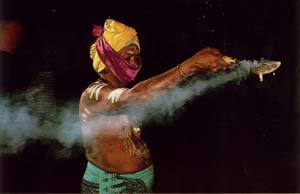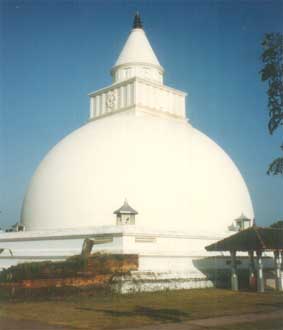|
| ||||||||||||
Kataragama's Metaphysical Heritage
By Patrick Harrigan
To scholars and devotees alike, Kataragama occupies a hallowed place among the shrines of the ever-youthful patron god of war, poetry, love, and mystery. Thanks in part to its isolation on the margins of Sinhala. Tamil, and Muslim societies, Kataragama preserves an ensemble of archaic beliefs and ritual practices, much of which date from remote antiquity. As such, Kataragama is a veritable fountain of information about timeless mysteries that were once common to all peoples worldwide. However, in keeping with the character of the deity and the reputed functions of his shrine, most of this information is either deliberately encrypted or concealed or otherwise confined to all but a handful of ritual participants. This veil of secrecy, the existence of which the hereditary custodians of Katirkama's traditions readily concede, is further enhanced by a relative dearth of literature and published findings by informed investigators. Indeed, modem interest has tended to focus upon the sideshows of ‘Murugan's Circus', as one veteran observer has aptly termed Kataragama, without ever identifying—let alone comprehending— its ‘main attraction'. From the perspective of informed participants and practitioners (Skt. sadhaka) on the other hand, it is clear that no scholarly study that overlooks the shrine's soteriological or metaphysical dimensions can ever succeed in discovering its raison d'etre. From this unanimous perspective, it is through the mysterious workings of divine grace (Tamil: arul) alone that doubts vanish and ‘meanings' become self-evident, and not through mere speculation based upon imported assumptions. Hence, when many thousands of devotees annually are able to access Kataragama's ample store of revealing grace, there is little no reason why researchers, too, should not avail themselves of this indispensable means to appreciate its mystery traditions. Worship at KataragamaThe foremost feature of worship of the Kataragama deity is that it is aniconic, i.e. without icons, idols, or images. To His Tamil devotees, the deity is regarded as the Supreme Identity (Tamil: kantazhi), which is explained as ‘reality transcending all categories, without attachment, without form, standing alone as the Self (naccinārkkiniyar). As such, only abstract symbols of His mystery (Skt: rahasya) are worshipped, such as the vel and the sadkona yantra (hexagram). For uncounted centuries, the custodians of the Kataragama shrine have conducted non-agamic, aniconic modes of worship including archaic rites which, the tradition maintains, have come down from the original inhabitants of prehistoric Lanka, the Veddas (Tamil: vedar). At Least until, recently, the Sinhalese kapuralas (priests, who explicitly trace their lineage back to the Veddas) still exercised their prerogative to hunt for deer in Deviyange Kaele (Sinhala: 'God's Own Forest') and to make an offering of the venison to the god on Saturdays. To this day, the Vedda or Wanniyal-aeto people of Lanka regard Kande Yaka, ‘the Spirit of the Mountain', as their god of the hunt who still extends guidance and protection to those who invoke Him. As a reminder to all that the shrine and its traditions were originally theirs, Veddas still attend the annual festival where they ritually ambush the god's procession and extract tribute from the Sinhalese custodians of the shrine. Local tradition maintains that King Duttugemunu (2nd Cent. B.C.E.) established (or, more likely, formalized and endowed an existing system of) rajakariya or ‘service to the king' whereby the prehistoric mystery rites were perpetuated in 505 hereditary roles incorporated into the annual fortnight-long festival in the month of Esala (July-August). For centuries, the Esala festival has attracted thousands of pilgrims who come from as far as Jaffna in the north or even from India including, notably Saint Arunagirinathar (13th-14th Cent. C.E.), who composed at least fourteen Tiruppukazh songs about Kataragama and one about Tirukonamalai (Trincomalee) which is en route. Until the nineteenth century, the pilgrimage used to attract large numbers of Muslim faqirs from India as well, but today it consists mainly of Tamil Hindu villagers from the East Coast. |
| Living Heritage Trust ©2021 All Rights Reserved |





